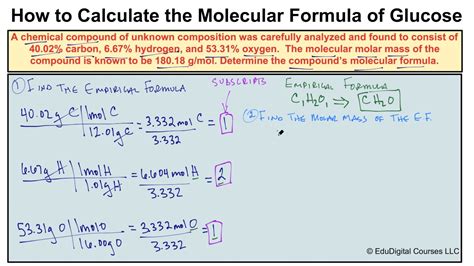How to Find the Molecular Formula: A Comprehensive Guide
Determining a molecule's molecular formula, which specifies the exact number of atoms of each element present, is crucial in chemistry. This guide provides a step-by-step approach to finding the molecular formula, covering both empirical formula determination and the transition to the molecular formula.
Understanding Empirical vs. Molecular Formulas
Before diving in, let's clarify the difference:
- Empirical Formula: This represents the simplest whole-number ratio of atoms in a compound. For example, the empirical formula for glucose is CH₂O.
- Molecular Formula: This shows the actual number of atoms of each element in a molecule. The molecular formula for glucose is C₆H₁₂O₆.
Often, you'll need to find the empirical formula first before determining the molecular formula.
Step 1: Finding the Empirical Formula
The empirical formula is usually determined through experimental data, specifically combustion analysis or other quantitative analysis methods. These methods provide the mass (or percentage) of each element in the compound. Here's how to proceed:
1.1 Convert percentages to grams:
Assume you have 100g of the unknown compound. Percentages then directly translate to grams of each element. For example, if a compound is 40% carbon and 60% oxygen, you have 40g of carbon and 60g of oxygen.
1.2 Convert grams to moles:
Divide the grams of each element by its molar mass (found on the periodic table). This gives you the number of moles of each element.
1.3 Determine the mole ratio:
Divide each mole value by the smallest mole value obtained in the previous step. This will give you the simplest whole-number ratio of atoms in the compound. You may need to multiply the ratios by a small integer to get whole numbers (e.g., 1.5 becomes 3/2, which you'd multiply by 2 to get 3 and 2).
1.4 Write the empirical formula:
Use the whole-number ratios from the previous step as subscripts for each element's symbol to write the empirical formula.
Step 2: Finding the Molecular Formula
To find the molecular formula, you need the empirical formula and the molar mass of the compound. The molar mass is often determined experimentally using techniques like mass spectrometry.
2.1 Calculate the empirical formula mass:
Add up the molar masses of all atoms in the empirical formula.
2.2 Determine the multiple (n):
Divide the experimental molar mass of the compound by the empirical formula mass. This gives you a whole number (or very close to a whole number), which represents the multiple by which the empirical formula needs to be multiplied.
2.3 Write the molecular formula:
Multiply the subscripts of each element in the empirical formula by 'n' to obtain the molecular formula.
Example:
Let's say we have a compound with 40% carbon and 60% oxygen and an experimentally determined molar mass of 180 g/mol.
-
Empirical Formula:
- 40g C / 12.01 g/mol = 3.33 mol C
- 60g O / 16.00 g/mol = 3.75 mol O
- Divide by the smallest (3.33): C: 1, O: 1.12 (approximately 1.12)
- Multiply by 2 to obtain whole numbers: C₂O₃
-
Molecular Formula:
- Empirical formula mass of C₂O₃ = 72 g/mol
- n = 180 g/mol / 72 g/mol = 2.5 (approximately 2.5. In reality, you might find a value of 2.5 due to experimental error. In such case, it indicates a likely multiple of 2. Rounding this to 3 is not always correct)
If you found n ≈ 2.5, and the molar mass is almost certainly correct (within experimental error), there might be something wrong with your empirical formula determination. Double-check your initial mass percentages, molar mass values, and calculations. It's rare to get non-integer values of n.
Therefore, in this example, if we get an n value of approximately 3 (after rechecking the work for errors), the molecular formula would be C₆O₉. (3 * C₂O₃).
Remember to always double-check your calculations and consider experimental error. Slight variations in experimental data can affect the final result. Understanding significant figures is vital for accuracy.
